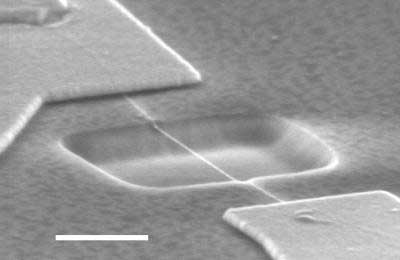| Posted: November 27, 2006 |
Nanotechnology makes world's smallest piano wire |
|
(Nanowerk News) Researchers from Delft University of Technology and FOM Foundation have successfully made and 'tuned' the world's smallest piano wire. The wires are made of carbon nanotubes that measure approximately 2 nanometers in diameter. The researchers have published an article on the subject this week in the scientific journal Nano Letters ("Bending-Mode Vibration of a Suspended Nanotube Resonator").
|
 |
SEM image of a suspended nanotube. (Image: TU Delft)
|
|
The researchers at the Kavli Institute of Nanoscience Delft and the FOM Foundation (Fundamental Research on Matter) made the small wires from carbon nanotubes, measuring approximately 1 micrometer long and approximately 2 nanometres in diameter. The tubes were attached to electrodes and initially placed above a layer of silicon oxide. This layer of silicon oxide was then partially etched away with acid, which caused the tubes to detach and hang.
|
|
A layer of silicon is contained beneath the silicon oxide. A strong and frequently variable alternating current is applied to this layer, which causes the hanging nanotubes to vibrate. The suspended tube is alternately attracted and repelled. The largest measured deviation for one tube was 8 nanometres. The distance of the nanotubes to the layer of silicon influences the electrical capacity to the layer of silicon. The movement of the nanowires is derived from these changes in capacity.
|
|
When the frequency of the applied current approaches the level of the suspended tube's eigenfrequency, it begins to vibrate more powerfully. The order of magnitude of these frequencies amounts to a few tens of MHz. By varying the strength and frequency of the applied current, the research group led by Professor Herre van der Zant succeeded in transposing the wire from a freely suspended state, to a state in which it is taut and vibrates. Van der Zant: "And as such it is like tightening a piano wire or guitar string. You can, as it were, tune the wire."
|
|
The Delft researchers have developed a model that can satisfactorily predict the vibrations of the nanotubes. The vibrating nanotubes are not only interesting from a scientific standpoint; in future they can also be used for other specific applications. Van der Zant identifies one possibility as a hypersensitive mass sensor. "The nanotubes are extremely lightweight. If you suspend something from the tube that is also extremely lightweight, like a virus, then the change in mass is rendered by a different vibration pattern. From this, you can determine the size of the extra mass and deduce if it involves the virus concerned." The vibrating tubes may also be of interest for GSM-related applications (which now use resonators that vibrate in the GHz-field.)
|

